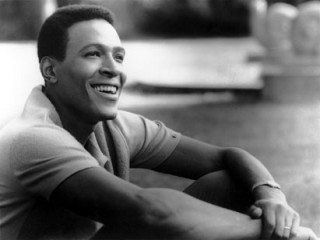
Marvin Gaye biography
Date of birth : 1939-04-02
Date of death : 1984-04-01
Birthplace : Washington, D.C.
Nationality : American
Category : Famous Figures
Last modified : 2011-04-02
Credited as : R&B and soul doo-wop singer, and songwriter, The Moonglows
0 votes so far
American soul singer-songwriter-producer who, to a large extent, ushered in the era of artist-controlled popular music of the 1970s. Gaye's father was a storefront preacher; his mother was a domestic worker. Gaye sang in his father's Evangelical church in Washington, D.C., and became a member of a nationally known doo-wop group, the Moonglows, under the direction of Harvey Fuqua, one of the genre's foremost maestros, who relocated the group to Chicago.
When doo-wop dissipated in the late 1950s, Gaye had already absorbed Fuqua's lessons in close harmony. After disbanding the Moonglows, Fuqua took the 20-year-old Gaye to Detroit, Michigan, where Berry Gordy, Jr., was forming Motown Records.
Gaye, who also played drums and piano, bucked the Motown system and its emphasis on teen hits. He was set on being a crooner in the Nat King Cole– Frank Sinatra vein, but his first efforts in that style failed. His break came with “Stubborn Kinda Fellow” (1962), the first of a long string of hits in the Motown mold—mainly songs written and produced by others, including “I'll Be Doggone” (1965), by Smokey Robinson, and “I Heard It Through the Grapevine” (1968), by Norman Whitfield. Gaye also enjoyed a series of successful duets, most notably with Tammi Terrell (“Ain't Nothing Like the Real Thing” [1968]).
Blessed with an exceptionally wide range that encompassed three distinct vocal styles—a piercing falsetto, a smooth mid-range tenor, and a deep gospel growl—Gaye combined great technical prowess with rare musical individuality. Rebellious by nature, he turned the tables on Motown's producer-driven hierarchy by becoming his own producer for What's Going On (1971), the most significant work of his career. A suite of jazz-influenced songs on the nature of America's political and social woes, this concept album—still a novel format at the time—painted a poignant landscape of America's black urban neighbourhoods. Gaye also displayed dazzling virtuosity by overdubbing (building sound track by track onto a single tape) his own voice three or four times to provide his own rich harmony, a technique he would employ for the rest of his career. What's Going On was a critical and commercial sensation in spite of the fact that Gordy, fearing its political content (and its stand against the Vietnam War), had argued against its release.
Other major artists—most importantly Stevie Wonder—followed Gaye's lead and acted as producer of their own efforts. In 1972 Gaye wrote the soundtrack for the film Trouble Man, with lyrics that mirrored his own sense of insecurity. Let's Get It On, released in 1973, displayed Gaye's sensuous side. I Want You (1976) was another meditation on libidinous liberation. Here, My Dear (1979) brilliantly dealt with Gaye's divorce from Gordy's sister Anna (the first of the singer's two tumultuous divorces).
Gaye's growing addiction to cocaine exacerbated his psychological struggles. Deeply indebted to the Internal Revenue Service, he fled the country, living in exile in England and Belgium, where he wrote “Sexual Healing” (1982), the song that signaled his comeback and led to his only Grammy Award.
Back in Los Angeles, his home from the 1970s, his essential conflict—between the sacred and secular—grew more intense. His 1983 “Sexual Healing” tour, his last, was marked by chaos and confusion. On April 1, 1984, during a family dispute, Gaye initiated a violent fight with his father, who shot him to death. Those close to the singer theorized that it was a death wish come true. For months before, he had toyed with suicide. Gaye, who cited his chief influences as Ray Charles, Clyde McPhatter, Rudy West (lead singer for the doo-wop group the Five Keys), and Little Willie John, was inducted into the Rock and Roll Hall of Fame in 1987.
As an artist who employed urban soul music to express social and personal concerns, as well as a singer of exquisite sensitivity and romantic grace, Gaye left a legacy that has widened since his demise, and his music has become a permanent fixture in American pop.
Albums:
1961 The Soulful Moods Of Marvin Gaye
1963 That Stubborn Kind Of Fella
1964 Recorded Live: On Stage
1964 When I'm Alone I Cry
1964 Together (with Mary Wells)
1965 Hello Broadway This Is Marvin
1965 How Sweet It Is To Be Loved By You
1965 A Tribute to The Great Nat King Cole
1966 Moods Of Marvin Gaye
1966 Take Two (with Kim Weston)
1967 United (with Tammi Terrell)
1968 In The Groove
1968 You're All I Need (with Terrell)
1969 Marvin Gaye And His Girls
1969 MPG
1970 That's The Way Love Is
1971 What's Going On
1972 Trouble Man (soundtrack)
1973 Let's Get It On
1973 Diana And Marvin (with Diana Ross)
1974 Live
1976 I Want You
1977 Live At The London Palladium
1978 Here My Dear
1981 In Our Lifetime
1982 Midnight Love
1985 Dream Of A Lifetime
1985 Romantically Yours
1991 The Last Concert Tour
1994 For The Very Last Time
Compilations:
1964 Marvin Gaye's Greatest Hits
1967 Marvin Gayes's Greatest Hits Vol. 2
1988 18 Greatest Hits
1990 Love Songs
1990 The Marvin Gaye Collection
1993 Night Life
1995 The Master: 1961-1984
1996 Early Classics


















